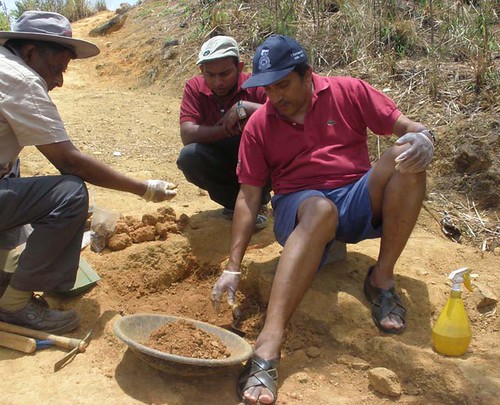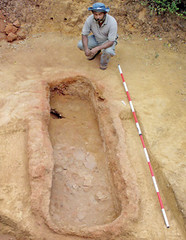
PREV ARTICLE
NEXT ARTICLE
FULL ISSUE
PREV FULL ISSUE
DIGGING OUR OWN GRAVE: KAVAN RATNATUNGA'S ARCHAEOLOGICAL DIG
Kavan Ratnatunga also authored an article in last week's Sunday Times of Sri Lanka called "Digging our own grave" where he "has his first experience of an archaeological dig up in the hills of Haldummulla".
-Editor
On the first day after instructions on the excavation and data recording process, we watched work being started on the primary burial site. All that was visible at first was the faint reddish outline of the top of the clay canoe on the gravel estate road. The first day's careful digging did not expose any artifacts. That evening we walked over to see a settlement on top of a nearby hill. The site was being used as a modern cemetery. The ground had much evidence of ancient artifacts - we picked up a few pieces of broken pottery (potsherds). Prof. Somadeva identified a small piece of quartz as a Microlith, a tool made of clear quartz used in the protohistorical period. Microliths have been found as items placed in burials, some of which date back 30,000 years. The next day we continued our instruction, as we watched the burial site being dug deeper and deeper. That evening we visited a second burial site nearby, the scientific usefulness of which had been sadly lost. This particular site had been previously dug by the villagers expecting to find treasure, after reading reports of last year's excavations. I requested Prof.Somadeva permission to excavate a part of that grave to find out what had been done to it. So it was that on the third day we put our instructions to practical use by starting to dig our own grave. We soon found lots of potsherds and burnt charcoal which were probably the human remains in that burial. It had clearly been just dug and refilled when the villagers found nothing of commercial value. At the primary site they had exposed the top layer of crushed pots in which the remains had been cremated. It appears that the skeletal remains from a grave had been brought to these burials to be cremated in these pots.

To read the complete article, see: Digging our own grave (www.sundaytimes.lk/110918/Plus/plus_05.html)
For some more images, see:
lakdiva.org/suntimes/haldummulla/
The Numismatic Bibliomania Society is a non-profit organization promoting numismatic literature. See our web site at coinbooks.org. To submit items for publication in The E-Sylum, write to the Editor at this address: whomren@gmail.com To subscribe go to: https://my.binhost.com/lists/listinfo/esylum All Rights Reserved. NBS Home Page Contact the NBS webmaster 
|
